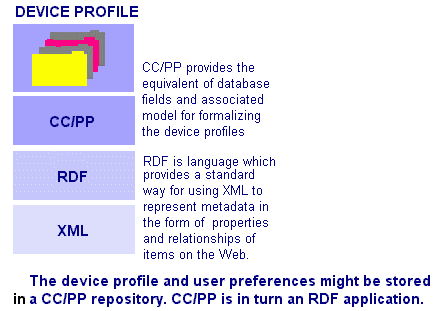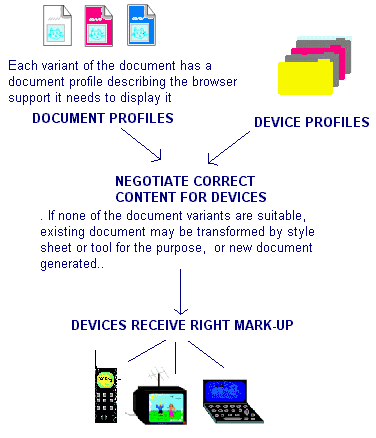The Mobile Access Activity was merged into the Device Independence Activty, and taken up by the Mobile Web Initiative. This page is no longer maintained.
Work on Mobile Access is part of W3C's User Interface domain.
The idea of access to the Web from any place and at any time is fast becoming a reality. Web information and services are becoming accessible from a wide range of mobile devices, from cellular phones, pagers, and in-car computers to palmtop computers and other small mobile devices. Many such devices are characterized by small screens, limited keyboard, low bandwidth connection, small memory and so on. W3C's Mobile Access Activity is working to ensure that the protocols and data formats of the Web provide an effective fit for all mobile devices. The Consortium is working towards worldwide standards for the technology involved, to the benefit of Web users and content providers alike.
The technology to enable mobile access to the Web is still in the early stage, and questions about languages and formats are very much open to discussion. The following section gives an overview of some of the ideas currently under consideration.
Mobile devices need special consideration when it comes to using Web information. Their displays are generally much smaller than a conventional computer screen and are capable of showing only a small amount of text. On a cellular phone, for example, there may be only enough space for three or four rows of text. Palm-top pocket-sized computers have screens smaller than a PC or laptop, but large enough to read email and documents with a small amount of text. Mobile devices have limited memory and processing speeds, and these considerations also need to be taken into account.
Given that mobile devices are different in their capabilities from ordinary PCs, what are the repercussions for markup? Because of the constraints explained above, mobile devices are unlikely to be able to use exactly the same markup as a normal page for a PC. Instead they will use a subset of HTML tags. The expectation is that different devices will make use of different modules of XHTML; similarly they will support different modules of style sheets. For example, one mobile device might use the basic XHTML text module and the style sheet voice module. Another device with a large screen might also allow the XHTML tables module.
The question is, given the needs of the various devices accessing the Web, how can the server know about the capabilities of individual devices? How can it know that a mobile phone with a very small screen is requesting a Web page, rather than a pocket-sized computer asking for the same information? The current idea is to store data about each device - and also the preferences of its user - as a device profile. The device profiles would be stored as a kind of relational database located on a Web server. W3C is working jointly with the WAP Forum writing the database model and likely fields that it will contain. This work is has led to the Composite Capability/Preference Profiles (CC/PP).

The Composite Capability/Preference Profiles (CC/PP): a user-side framework for content negotiation was issued as a W3C Note on 30th November, 1998. A Composite Capability/Preference Profile is a collection of information which describes the capabilities, hardware, system software and applications used by someone accessing the Web, as well as the particular preferences of the users themselves. Information might include the preferred language, sound on/off, images on/off, class of device (phone, PC, printer, etc.), screen size, available bandwidth, version of HTML supported, and so on.
Following that work, the W3C Note "CC/PP exchange protocol based on HTTP Extension Framework" describes an application of the HTTP Extension Framework to exchange CC/PP information effectively over HTTP/1.1. These works have led to the creation of the CC/PP Working Group.
The theory is that, when a device makes a request over the Web for a Web page, a pointer to the device profile is appended to the request. In the case of a mobile phone, not only would the phone request a URI in the usual way, but it would also send a pointer in the form of a second URI to indicate where its device profile could be found.
The critical piece in the puzzle is that the "pointer" URI goes straight to the CC/PP database. CC/PP is written in Resource Description Framework (RDF), W3C's language for modeling metadata - descriptive information about items on the Web. The whole point of RDF is that information encoded is always linked to Web addresses, for example: "the device with Web address http://www.deviceprofiles.example.com/abc1234 has the following profile..." etc. This means that by sending a URI for the device profile, all kinds of data about that device immediately becomes available.
The device profile is known, and the Web information required is understood. How now to match the right version of that Web information in terms of markup and style, to the device?
XHTML is being designed as a series of modules associated with different functionality: text, tables, forms, images etc. Future Cascading Style Sheets (CSS) and Synchronized Multimedia Integration Language (SMIL) specifications will have the same modular construction. If a content provider wants information to be available for different devices, different versions of that content can be generated, for example using only the text modules, or perhaps using full graphics with scripting. Thus in its document profile, the document specifies the expected capabilities of the browser in terms of XHTML support, style sheet support and so on. During the process of matching, the document profile would be compared with the device profile, the best fit between the two would be discovered, and a suitable document would be generated or the best fitting variant would be selected.

A wide range of people and organizations are interested in the mobile access technology area, from hardware manufacturers to software companies and communication service content providers. W3C's involvement started relatively recently. Following the success of an initial W3C Workshop held in Tokyo in Japan in April 1998, a Mobile Access Interest Group was created. In June 1998, a meeting was held with the WAP Forum, and since that initial meeting, W3C has been working with the WAP Forum (for the curious, WAP stands for "Wireless Application Protocol"). While the WAP Forum and W3C have different organizational goals, they share common goals for the future of the global Internet, and are both committed to the efficient delivery of Internet content to wireless devices (literally, those not wired up to the Internet via a cable - as is, for example, a PC or laptop). The WAP Forum aims to create a global wireless protocol specification that works across differing wireless network technology types, for adoption by appropriate industry standards bodies.
W3C sent out a call for participation in the Device Independence Working Group on 30 January 2001.
The CC/PP Working Group was formed in August 1999. The mission of this Working Group is to develop an RDF-based framework for the management of device profile information. The Working Group is looking into what mechanisms make device profiles work, how to extend the model and vocabulary devised, and so on. The Working Group works in close cooperation with other Working Groups in the W3C.
The W3C Mobile Access Interest Group is a forum for W3C Members to discuss issues related to mobile Web access. There is also an archived public mailing list, www-mobile@w3.org, for technical discussion about mobile access. The Mobile Access Interest Group has produced a series of technical documents. .
W3C's Device Independence Activity replaced the Mobile Access and TV & the Web Activities in January 2001. The CC/PP Working Group, the Mobile Access Interest Group, and the Device Independence Working Group are all part of this new Activity.
The CC/PP Working Group has published the following Working Drafts. The latest versions were published on 21 July 2000.
The first CC/PP Implementors Days was held in Karlstad, Sweden, on November 15 and 16, 2000.
The charter of the CC/PP Working Group has been extended to December 2001.
The Mobile Access Interest Group has produced the following documents:
As XHTML becomes more widely adopted, mobile devices will be sold with browsers which support certain subset of XHTML, and they may also support some additional modules. The group has helped the HTML Working Group to design XHTML Basic, which is targeted for such mobile devices.
The charter of the Mobile Access Interest Group has been extended to November 2001.